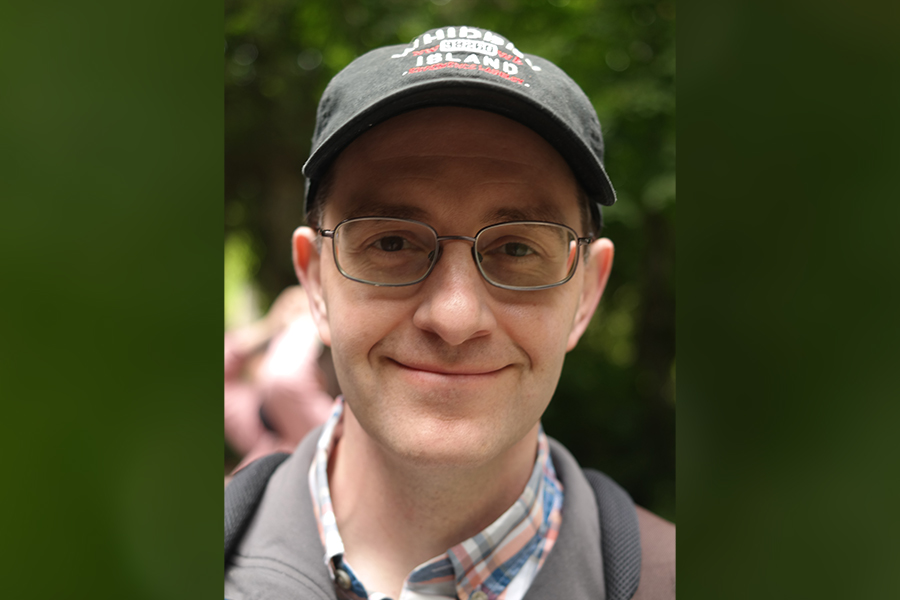Faculty Spotlight: Kevin Huffenberger

Kevin Huffenberger is an associate professor in the Department of Physics, part of Florida State University’s College of Arts and Sciences. He earned his doctorate in 2006 from Princeton University, and his research focuses on physical cosmology, which is the study of the large-scale universe, with an emphasis on cosmic microwave background data analysis. From 2014-2021, Huffenberger chaired the committee overseeing Saturday Morning Physics, a program that gives community members an opportunity to learn basic physics from respected Florida State University physics faculty.
Tell us a little about your background and what brought you to FSU.
I grew up near Columbus, Ohio. I earned degrees in math and physics at the University of Illinois and then received my doctorate from Princeton University. I worked as a postdoctoral fellow at Caltech and the Jet Propulsion Laboratory before joining the faculty at the University of Miami. I moved to Florida State University in 2013 to join the astrophysics group in the physics department.
You study and research a broad array of topics in astrophysics; can you break down your areas of interest for us?
We try to discover the contents of the universe and the rules that govern it. We look at the cosmic microwave background (CMB) radiation, which is a left-over glow from the hot, dense gas in the early universe. This cosmic radiation documents the conditions 400,000 years after the Big Bang, early in the universe’s 14-billion-year history. If we could see it with our eyes, it would resemble a cloudy sky. Slight variations in the temperature of the incoming radiation from different directions carry information about the early universe. For example, a slightly cold spot in the sky’s radiation indicates a matter concentration because the radiation lost energy climbing out of that matter's gravitational well. The radiation's polarization (the orientation of the electromagnetic waves) partially records the motion of early gas.
We also use the CMB as a well-characterized backlight that highlights foreground structures (like gas in clusters of galaxies). When observing, we incidentally capture microwave radiation from other objects, like black holes and stars. We measure the CMB by scanning the sky with a specialized telescope and then assemble the scanning data into maps of the sky. My main area of study is figuring out how to reliably draw conclusions about the contents and properties of the universe from the primeval images we obtain.
What inspired you to choose your fields of study?
I've always had broad interests. My parents, both first generation college students, emphasized the importance of education. My dad was enthusiastic about astronomy, and we had telescopes around the house, although I never learned to use them well. I watched lots of science documentaries on television. When I was in high school, I had an audiobook about black holes and the early universe that I listened to as I went to sleep. For college, I was thinking about chemistry or computer science but decided on physics. In my last year, one of my courses gave me my first look at the physics of the large-scale universe. Once I started graduate school, I joined a group working on that topic and stuck with it.
Tell us about the research you’ve conducted over the past couple of years with the Huffenberger Cosmology Group.
We are interested in measuring gravitational waves in the early universe. Such ripples in spacetime are predicted to accompany the inflationary expansion that's predicted in most models for the universe's first fraction of a second - the Big Bang. If these waves exist, we should be able to see them squeeze and stretch the primordial plasma through signatures in the polarization of the CMB. The problem is that this signature is fainter than microwaves produced by gas and dust in our galaxy. Recently, we have made several efforts to study the effects of these Milky Way contaminants, so we can subtract or mitigate them when we measure these gravitational waves. In other projects, we have used the CMB to learn about the large-scale distribution of galaxies and dark matter throughout the universe by looking at how those structures bend CMB light with their gravity.
What do you want the public to know about your research, and why is it important?
Studying the origins and structures of the universe probes fundamental questions about nature and where it comes from. The tools we use and develop have practical uses that are less esoteric. By training students and junior researchers, we build the technical proficiency of our society's human capital. Our measurements push the technological forefront: Our telescopes use cyrogenic, superconducting sensors to measure tiny radiation fluctuations. My group employs computer image processing and filtering, image noise reduction and enhancement, automated and computer-based classification of phenomena, harmonic analysis, statistical characterization of large data sets, parallel computing algorithms, and other data analysis techniques that have broad applicability to science and industry.
How has COVID-19 affected your teaching and research?
My research collaborations already used teleconferences, so the transition to online teaching was relatively smooth. It's strange to have students and colleagues you know more by voice than appearance. There is less travel, and conferences have moved online. My meetings with students and junior researchers in my group all had to move online, which works well, but it's not like standing together at the blackboard.
If your students only learned one thing from you (of course, hopefully, they learn much more than that), what would you hope it to be?
Scientists measure things or try to understand others' measurements or suggest new measurements to make. Fundamentally, there are rules that govern objects in nature, and we can learn them by making these measurements. The rules may be complicated, but people can make great progress in figuring them out using experiments, observations and mathematical models.

